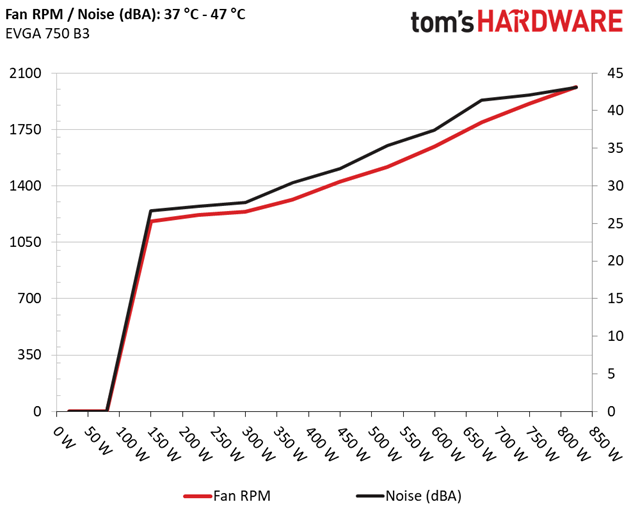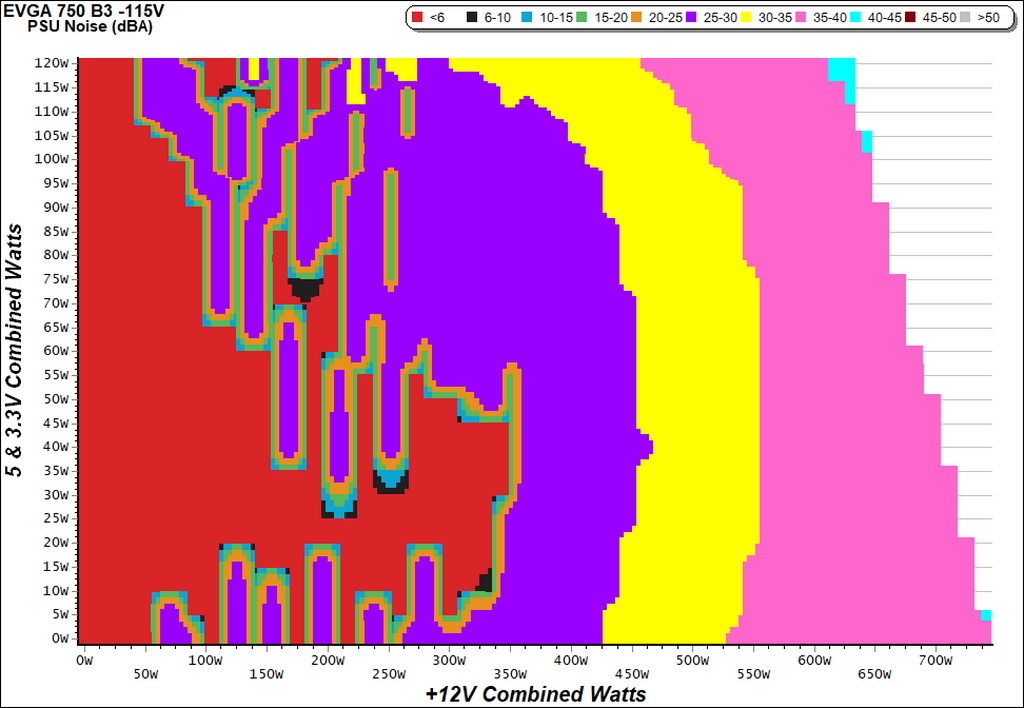EVGA 750 B3 PSU Review
Why you can trust Tom's Hardware
Efficiency, Temperature & Noise
Efficiency
Our efficiency testing procedure is detailed here.
Using results from the previous page, we plotted a chart showing the 750 B3's efficiency at low loads, and loads from 10 to 110 percent of its maximum-rated capacity.

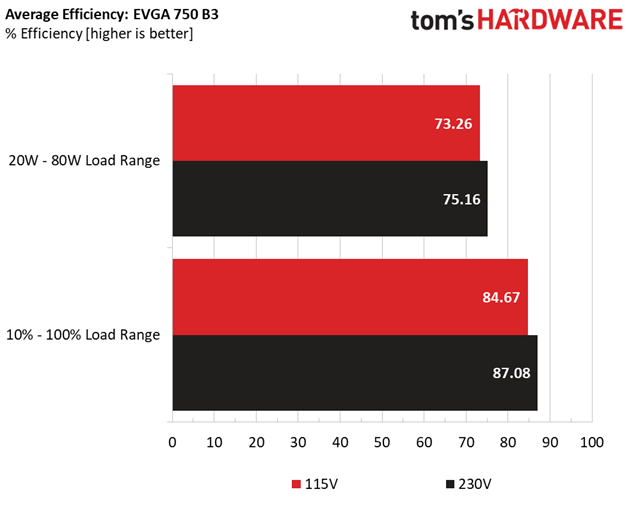
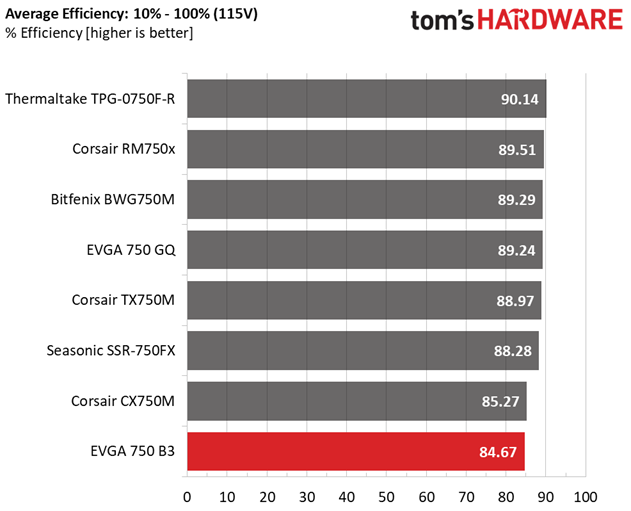
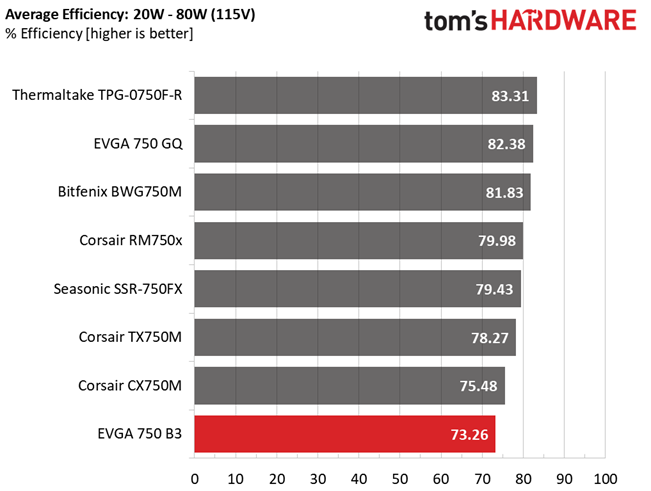
Despite the half-bridge topology and LLC resonant converter, EVGA's efficiency levels are quite low under both normal and light loads.
Efficiency At Low Loads
In the following tests, we measure the 750 B3's efficiency at loads significantly lower than 10 percent of its maximum capacity (the lowest load the 80 PLUS standard measures). The loads we dialed were 20, 40, 60, and 80W. This is important for representing when a PC is idle, with power-saving features turned on.
| Test # | 12V | 5V | 3.3V | 5VSB | DC/AC (Watts) | Efficiency | Fan Speed | Fan Noise | PF/AC Volts |
|---|---|---|---|---|---|---|---|---|---|
| 1 | 1.202A | 0.493A | 0.479A | 0.195A | 19.667 | 62.965% | 0 RPM | <6 dB(A) | 0.834 |
| 12.136V | 5.055V | 3.323V | 5.110V | 31.235 | 115.18V | ||||
| 2 | 2.430A | 0.981A | 0.991A | 0.391A | 39.721 | 74.065% | 0 RPM | <6 dB(A) | 0.929 |
| 12.132V | 5.053V | 3.321V | 5.097V | 53.630 | 115.19V | ||||
| 3 | 3.664A | 1.478A | 1.504A | 5.083A | 59.893 | 77.011% | 0 RPM | <6 dB(A) | 0.941 |
| 12.128V | 5.052V | 3.321V | 5.083V | 77.772 | 115.19V | ||||
| 4 | 4.881A | 1.983A | 1.985A | 0.785A | 79.767 | 78.988% | 0 RPM | <6 dB(A) | 0.959 |
| 12.126V | 5.049V | 3.319V | 5.070V | 100.986 | 115.19V |
Again, the 750 B3's efficiency levels under light loads are quite low. You cannot expect much in these tests from a PSU with Bronze and ETA-D efficiency certifications.
5VSB Efficiency
The ATX specification, along with CEC, ErP Lot 3 2014 and ErP Lot 6 2010/2013, states that 5VSB standby supply efficiency should be as high as possible, recommending 75 percent or higher with 550mA, 1A, and 1.5A of load. The PSU should also achieve higher than 75% efficiency at 5VSB under full load, or with 3A if its max current output on this rail is higher than 3A.
We take six measurements: one each at 100, 250, 550, 1000, and 1500mA, and one with the full load the 5VSB rail can handle.
Get Tom's Hardware's best news and in-depth reviews, straight to your inbox.
| Test # | 5VSB | DC/AC (Watts) | Efficiency | PF/AC Volts |
|---|---|---|---|---|
| 1 | 0.102A | 0.520 | 67.885% | 0.059 |
| 5.121V | 0.766 | 115.15V | ||
| 2 | 0.252A | 1.287 | 74.350% | 0.126 |
| 5.114V | 1.731 | 115.15V | ||
| 3 | 0.542A | 2.765 | 76.806% | 0.228 |
| 5.100V | 3.600 | 115.16V | ||
| 4 | 1.002A | 5.087 | 77.723% | 0.327 |
| 5.077V | 6.545 | 115.16V | ||
| 5 | 1.502A | 7.586 | 77.901% | 0.386 |
| 5.052V | 9.738 | 115.16V | ||
| 6 | 3.001A | 14.911 | 76.049% | 0.465 |
| 4.969V | 19.607 | 115.16V |

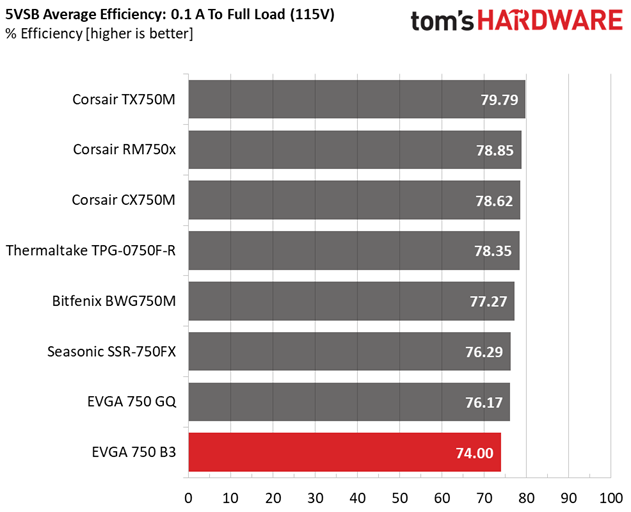
The 5VSB rail needs to be upgraded as soon as possible; it suffers very low efficiency across its entire operating range. Unfortunately, Super Flower doesn't pay much attention to this rail, so even its high-end platforms demonstrate low efficiency at 5VSB. This issue was pointed out by Cybenetics, which takes the 5VSB rail's efficiency into account when calculating a final rating. In contrast, 80 PLUS doesn't deal with 5VSB at all. Nonetheless, the ATX spec imposes some fairly strict efficiency requirements on this rail. And there are, of course, other requirements that deal with the 5VSB rail's efficiency (CEC and ErP Lot 6/3).
Power Consumption In Idle And Standby
In the table below, you'll find the power consumption and voltage values of all rails (except -12V) when the PSU is idle (powered on, but without any load on its rails), and the power consumption when the PSU is in standby mode (without any load, at 5VSB).
| Mode | 12V | 5V | 3.3V | 5VSB | Watts | PF/AC Volts |
|---|---|---|---|---|---|---|
| Idle | 12.139V | 5.056V | 3.323V | 5.123V | 9.758 | 0.477 |
| 115.2V | ||||||
| Standby | 0.129 | 0.010 | ||||
| 115.2V |
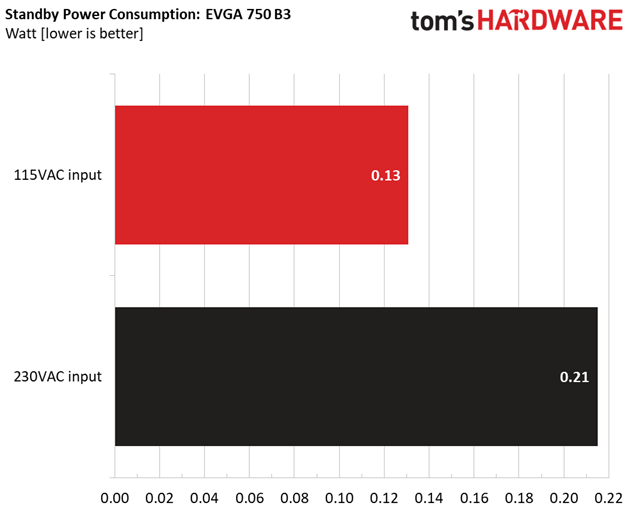
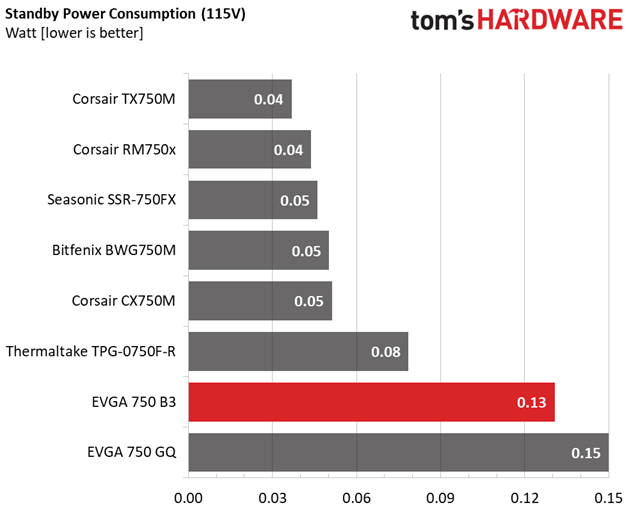
The phantom power levels we observe are higher than normal.
Fan RPM, Delta Temperature, And Output Noise
Our mixed noise testing is described in detail here.
The first chart below illustrates the cooling fan's speed (in RPM), and the delta between input and output temperature. The results were obtained at 37°C (98.6°F) to 47°C (116.6°F) ambient temperature.
The next chart shows the cooling fan's speed (again, in RPM) and output noise. We measured acoustics from one meter away, inside a hemi-anechoic chamber. Background noise inside the chamber was below 6 dB(A) during testing (it's actually much lower, but our sound meter’s microphone hits its floor), and the results were obtained with the PSU operating at 37°C (98.6°F) to 47°C (116.6°F) ambient temperature.
The following graph illustrates the fan's output noise over the PSU's operating range. The same conditions of the above graph apply to our measurements, though the ambient temperature was between 30°C (86°F) to 32°C (89.6°F).
EVGA's semi-passive mode lasts long enough, given this PSU's low efficiency. Its noise levels exceed 30 dB(A) with over 425W load at +12V; with 100W more, the output noise is within the 35-40 dB(A) range.
MORE: Best Power Supplies
MORE: How We Test Power Supplies
MORE: All Power Supply Content
Current page: Efficiency, Temperature & Noise
Prev Page Load Regulation, Hold-Up Time & Inrush Current Next Page Protection Features
Aris Mpitziopoulos is a contributing editor at Tom's Hardware, covering PSUs.
-
Dark Lord of Tech Several complaints in the forums from builders , very disappointed with the B3 series.Reply -
logainofhades Yea, I will no longer recommend a B3 series PSU. Seasonic and Corsair's new CX450m-650m are better options right now.Reply -
SinxarKnights The solder quality between review samples and retail samples is pretty shady in of itself IMO.Reply -
10tacle The fact that EVGA hasn't even responded to the 450W B3 fail test that was back in August is highly disturbing in an of itself. It is inexcusable to just ignore a tech website's inquiry (and serious concerns) as to why a series of their products are failing. I know EVGA's customer support is top notch in the industry (I've had to use it), but their public/customer relations team needs an overhaul. If I were the CEO, I'd be calling for some heads and light a fire under some backsides to ride Super Flower hard for a fix.Reply -
maxwellmelon with out them identifying the failed component how can they say that the PSU not turning back on after a OPP is not intentional setup because it being shut down at 120% of load is about right like they said. It could be designed that way as a safety feature. and a way to sell more psu because when you try to RMA it they can say you overloaded it and is not covered. Operating above 750 watts is above the psu limits and having a one time OPP shut down is still technically having OPP on it.Reply -
Aris_Mp When a PSU is broken after OPP's triggering, it is not a feature but a problem. OPP along with the rest of the protections is there to protect the PSU in order not to break when a user goes wild with it.Reply -
Lutfij The third paragraph of the last page reminded me of what cars with all souped up aftermarket parts but a crappy driver often results with - disaster.Reply
EVGA Have recently come under flack on other forums as well and their response isn't, erm, admirable. Nice work with the review, Aris, keep it up! -
rtansey378 They must be having issues in the CS department. After dealing with them for an RMA I found their website to be down totally twice and fundamentally broken in important other areas during RMA submission. I was getting different answers from different people to basic questions and there were unreturned emails that led to other issues - it was kind of a nightmare overall that went on for a month. Even after being expedited to a manager of some type it wasn't much better. And their 2-3 advance RMA uses UPS ground so it is not 2-3 days at all. It routinely takes them 3 days to get the replacement into UPS' hands and then UPS takes their sweet time. People also use their expensive desktop PCs for work. I went through that twice as they sent the wrong unit back the first time.Reply
They charge a premium largely on their CS reputation. I guess they are now hoping people won't have to use it and learn otherwise. Being branded as a good guy in the CS is huge. Being branded as a bad guy is a death sentence. You'd think they would at least return major website emails and spin use some good old corporate spin. They won't even do that. Makes you wonder.
I hope they figure it out. But Im no longer going to pay their premium. If they have the cheaper product then I would still consider them. That will rarely be the case. They did some nice patented stuff with their GTX 1070/1080 revisions so maybe they are putting all their eggs in that basket. -
mlee 2500 Wow, I expect better from something EVGA puts their name on.Reply
THANK YOU tom's HARDWARE for performing objective tests on multiple samples to keep us informed and the vendors honest....
I seriously could have seen myself buying my next PSU based on EVGA's reputation alone. I won't make that that mistake now.

